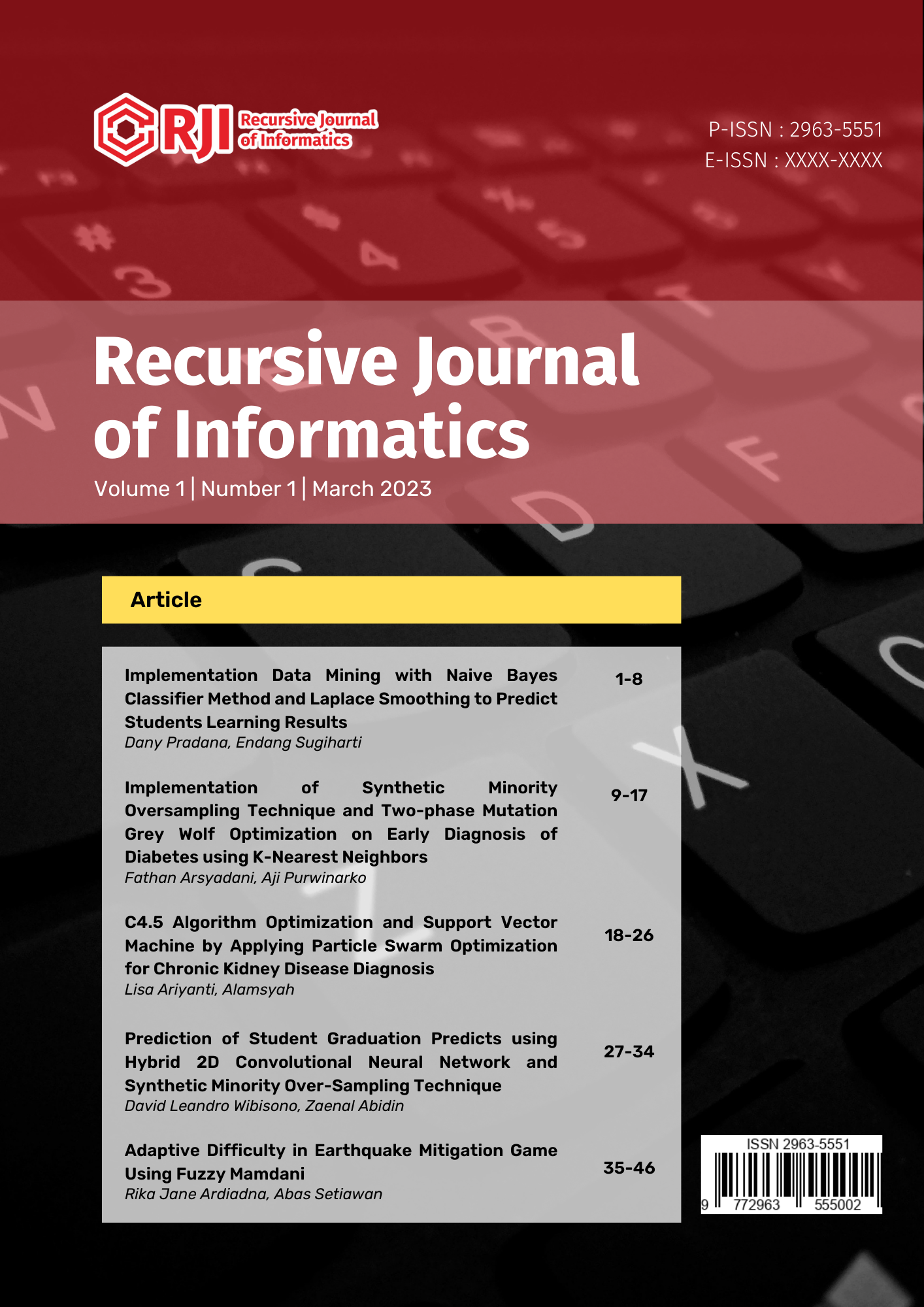Prediction of Student Graduation Predicts using Hybrid 2D Convolutional Neural Network and Synthetic Minority Over-Sampling Technique
Abstract
Abstract. With the rapid growth of technology, educational institutions are constantly looking for ways to improve their services and enhance student performance. One of the significant challenges in higher education is predicting the graduation outcome of students. Predicting student graduation can help educators and academic advisors to provide early intervention and support to students who may be at risk of not graduating on time. In this paper, we propose a hybrid 2D convolutional neural network (CNN) and synthetic minority over-sampling technique (SMOTE) to predict the graduation outcome of students.
Purpose: Knowing the results and how the Hybrid 2D Convolutional Neural Network (CNN) and Synthetic Minority Over-sampling Technique (SMOTE) algorithms work in predicting student graduation predicates. This algorithm uses a dataset based on family background variables and academic data.
Methods/Study design/approach: This study uses the Hybrid 2D CNN algorithm for the classification process and SMOTE for the minority class over-sampling.
Result/Findings: The prediction accuracy of the model using SMOTE is 96.31%. Meanwhile, the model that does not use SMOTE obtains an accuracy of 95.32%.
Novelty/Originality/Value: This research shows that the use of a Hybrid 2D CNN algorithm with SMOTE gives better accuracy than without using SMOTE. The dataset used also proves that family background and student academic data can be used as a reference for predicting student graduation predicates.
References
[2] F. Kusumawati and E. Nurhidayati, “Analisis Faktor-faktor yang Mempengaruhi Prestasi Belajar Pada Mahasiswa Semester II Program Studi DIII Kebidanan Stikes ‘Aisyiyah Yogyakarta Tahun 2013 1,” 2013.
[3] S. Poudyal, M. J. Mohammadi-Aragh, and J. E. Ball, “Prediction of Student Academic Performance Using a Hybrid 2D CNN Model,” Electronics (Switzerland), vol. 11, no. 7, Apr. 2022, doi: 10.3390/electronics11071005.
[4] G. Haixiang, L. Yijing, J. Shang, G. Mingyun, H. Yuanyue, and G. Bing, “Learning from class-imbalanced data: Review of methods and applications,” Expert Systems with Applications, vol. 73. Elsevier Ltd, pp. 220–239, May 01, 2017. doi: 10.1016/j.eswa.2016.12.035.
[5] Z. Xu, D. Shen, T. Nie, and Y. Kou, “A hybrid sampling algorithm combining M-SMOTE and ENN based on Random forest for medical imbalanced data,” J Biomed Inform, vol. 107, Jul. 2020, doi: 10.1016/j.jbi.2020.103465.
[6] X. Zhang, J. Ran, and J. Mi, “An Intrusion Detection System Based on Convolutional Neural Network for Imbalanced Network Traffic,” in IEEE 7th International Conference on Computer Science and Network Technology (ICCSNT), 2019, pp. 456–460.
[7] S. Krishnan, M. J. Franklin, K. Goldberg, J. Wang, and E. Wu, “ActiveClean: An interactive data cleaning framework for modern machine learning,” in Proceedings of the ACM SIGMOD International Conference on Management of Data, Jun. 2016, vol. 26-June-2016, pp. 2117–2120. doi: 10.1145/2882903.2899409.
[8] J. Luengo, S. García, and F. Herrera, “On the choice of the best imputation methods for missing values considering three groups of classification methods,” Knowl Inf Syst, vol. 32, no. 1, pp. 77–108, Jul. 2012, doi: 10.1007/s10115-011-0424-2.
[9] B. Frénay and M. Verleysen, “Classification in the presence of label noise: A survey,” IEEE Trans Neural Netw Learn Syst, vol. 25, no. 5, pp. 845–869, 2014, doi: 10.1109/TNNLS.2013.2292894.
[10] N. V. Chawla, K. W. Bowyer, L. O. Hall, and W. P. Kegelmeyer, “SMOTE: Synthetic Minority Over-sampling Technique,” Journal of Artificial Intelligence Research, vol. 16, pp. 321–357, Jun. 2002, doi: 10.1613/jair.953.
[11] T. D. K. Thara, P. S. Prema, and F. Xiong, “Auto-detection of epileptic seizure events using deep neural network with different feature scaling techniques,” Pattern Recognit Lett, vol. 128, pp. 544–550, Dec. 2019, doi: 10.1016/j.patrec.2019.10.029.
[12] C.-C. Kiu, “Data Mining Analysis on Student’s Academic Performance through Exploration of Student’s Background and Social Activities,” in 2018 Fourth International Conference on Advances in Computing, Communication & Automation (ICACCA), 2018.









